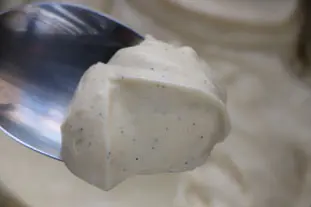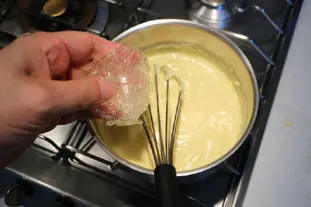The gelling agent in a cream

If you start making a Bavarian cream for example, or any other that contains a gelling agent such as gelatin or agar-agar, you will sooner or later be confronted with the problem: How to properly incorporate this gelling agent into my cream? (and we will focus on gelatin)
14 K 4.9/5 (19 reviews)
Keywords for this post:Gelling agentIncorporationDispersionCreamGelatinBlenderLast modified on: June 18th 2022
The gelling agent in a cream
"Well" means regularly, evenly, so that the consistency of the cream is well homogeneous, and it is not so easy as that.
Well it is often the case in fact, we heat a first mixture for a cooking (like custard) and then we incorporate the gelatin, but it is necessary to remember it anyway.
Then it's a question of structure, the gelatin is in a different form from your cream, which is rather liquid.
The gelatin is either sheets (of 2 gr) or powder, and incorporating it into the structure of your future cream involves some precautions.
If you use powdered gelatin, it's easier: you pour the powder directly into your hot cream, whisking at the same time to disperse immediately.
In practice, you may have some concerns about the homogeneity of your cream, with some areas a little more set than others, especially if your cream was a little low in temperature (< 50°C).
Not only will you disperse the gelatin perfectly, but you will also smooth your cream, which will be even smoother once it has cooled.
This dispersal of gelatin, and of gelifiers in general, in a mixer is a common practice among professional pastry chefs.
Don't hesitate to use this professional trick to obtain very nice and creamy creams at home.
To sum up: To properly incorporate a gelling agent into a cream, you must make it "hot cream" and then disperse it with a mixer for a homogeneous result.
What is the problem?
First of all, it's a question of temperature: gelatin is soluble at 37°C, so it is imperative that your cream is above that temperature, otherwise it will not dissolve.Well it is often the case in fact, we heat a first mixture for a cooking (like custard) and then we incorporate the gelatin, but it is necessary to remember it anyway.
Then it's a question of structure, the gelatin is in a different form from your cream, which is rather liquid.
The gelatin is either sheets (of 2 gr) or powder, and incorporating it into the structure of your future cream involves some precautions.
Sheets and powder
If you use gelatin sheets, you will first have to soften them for 5 minutes in a bowl of cold water, then wring them out (squeeze them in your hand over the sink), pour them into your hot cream and immediately mix them well, we say "disperse", with a whisk for example or with a maryse.
If you use powdered gelatin, it's easier: you pour the powder directly into your hot cream, whisking at the same time to disperse immediately.
Is this enough?
In theory yes, if you did it quickly and well, no problem for your cream.In practice, you may have some concerns about the homogeneity of your cream, with some areas a little more set than others, especially if your cream was a little low in temperature (< 50°C).
Is there a way to ensure a perfect dispersion?
Yes, just give your cream a quick blast with a mixer (less than 10 seconds) once the gelatin is incorporated.Not only will you disperse the gelatin perfectly, but you will also smooth your cream, which will be even smoother once it has cooled.

This dispersal of gelatin, and of gelifiers in general, in a mixer is a common practice among professional pastry chefs.
Don't hesitate to use this professional trick to obtain very nice and creamy creams at home.
To sum up: To properly incorporate a gelling agent into a cream, you must make it "hot cream" and then disperse it with a mixer for a homogeneous result.
Lasts posts
Getting out of the fridge early
Very often when you're cooking, you need to take food or preparations out of the fridge, to use them in the recipe in progress. There's nothing tricky about this: you just take them out of the fridge and use them, usually immediately, in the recipe. But is this really a good method?November 24th 20258265
Who's making the croissants?
When you look at a bakery from the outside, you naturally think that in the bakery, the bakers make the bread, and in the laboratory, the pastry chefs make the cakes. It's very often like that, with each of these professions having quite different ways of working, but sometimes there's also one...November 23th 2025753
Oven height
When we put a dish or cake in the oven, we naturally tend to put it on the middle shelf, and that's what we usually do. But in some cases, this position and height can be a little tricky, so let's find out why.October 8th 20252,3025
The importance of sieving
In recipes that use a fine powder (flour, powdered sugar, etc.), you'll often see the advice to sift before using it. To sift is to pass the powder in question through a sieve (a very fine strainer) before incorporating it into your recipe. It's often advice, but is it really useful?September 3rd 20257,2673
The grease spray
As soon as you have something in a recipe that sticks to the mold, the question always arises as to how difficult it is to remove from the mold. There's nothing more frustrating than breaking your cake when unmolding it, because part of it has stuck in the mold. The classic way to avoid this is...August 26th 20256,7965
Other pages you may also like
Candied fruits: don't get ripped off
Do you like candied fruit? You might like to nibble a handful or add it to a recipe, like a classic fruit cake or delicious Italian specialities like panettone or sicilian epiphany pie.June 21th 201767 K 24.2
The cake and the raisins
When you bake a cake, like a cake or pound cake, you may have already encountered this thorny problem: How to make sure that the raisins, or the candied fruits, or any other small filling, do not fall to the bottom of the pan during the baking process?May 31th 201915 K4.7
Cooking time for pasta
What is as good and simple as pasta? Not much, I think, and it's so easy to prepare: boiling water, salted (or not, depending on your taste), a few minutes of boiling and it's ready. The only "difficulty", so to speak, is the respect of the cooking time and the risk of, unfortunately, overcooking...July 18th 201923 K4.6
The window-pane test in bread-making
The home bread-makers often ask themselves “Have I kneaded my dough long enough?” . A good question, as dough that is insufficiently kneaded will not rise properly or will fall flat when the top is slashed, which is very frustrating. To know when the dough is ready, one can rely on the length...June 16th 202196 K 23.9
Using stretch food film effectively
Maybe you use food film in your own kitchen. You know, the very thin, clear plastic stuff that you can stretch, often used to cover food and protect it from the air. It’s become so widely used that it’s now an essential item for pros. They even have a verb for it in French: “filmer”: to...May 12th 201823 K 14.9
Post a comment or question
Follow this page (as 2 people already do)
If you are interested in this page, you can "follow" it, by entering your email address here. You will then receive a notification immediately each time the page is modified or a new comment is added. Please note that you will need to confirm this following.
Note: We'll never share your e-mail address with anyone else.
Alternatively: you can subscribe to the mailing list of cooling-ez.com , you will receive a e-mail for each new recipe published on the site.









